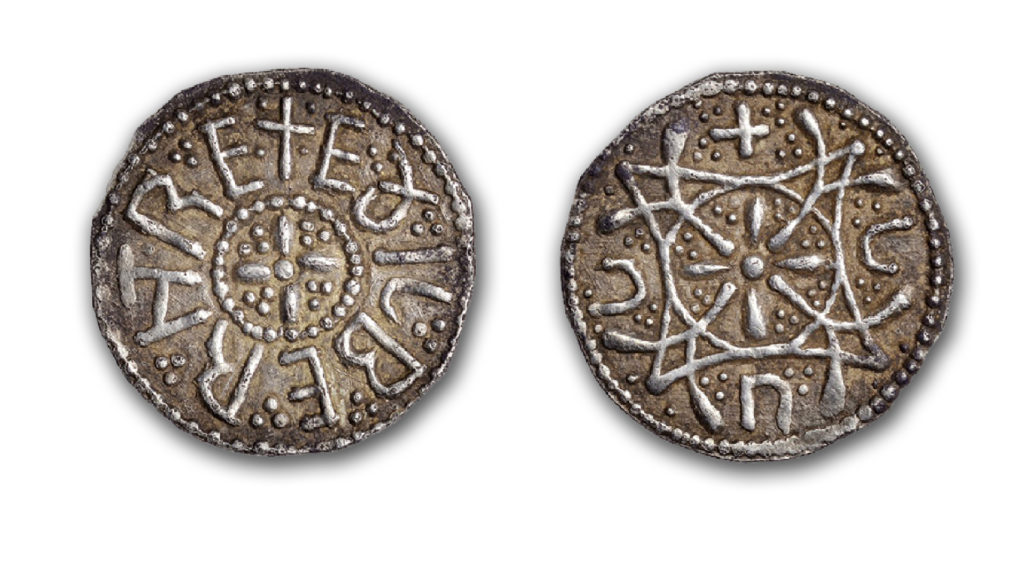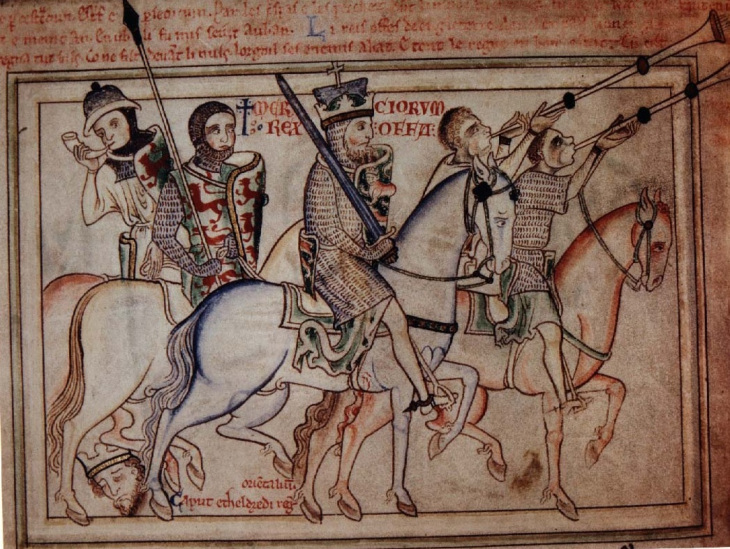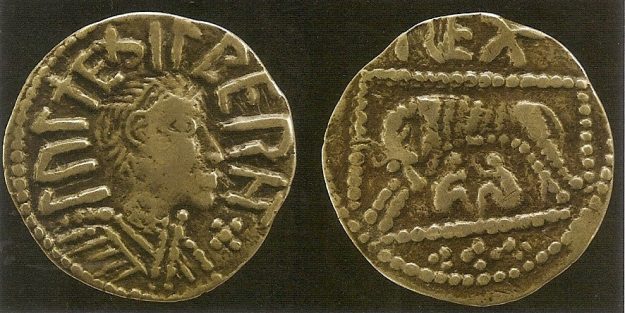
When I say the name Saint Æthelberht, I can forgive you for being nonplussed. Perhaps even baffled when I confirm that there was not one but two individuals of that name to be canonised in the shadows of ‘Dark Age’ England.
The first heralded from Kent, would earn the epithet ‘bretwalda’ [‘Britain-ruler’] during his lifetime, and has been celebrated forevermore as the first ‘English’ king to convert to Christianity at the Isle of Thanet in around AD 597.
The second is far a more mysterious character, his birth year uncertain, and his name all but erased from history, were it not for a passing mention in the Anglo-Saxon Chronicle, and four enigmatic silver coins. If one is fortunate, one may even stumble across the story of St Albright, the patron of Hereford Cathedral, and the idols of a similar name found at several parochial churches dotted around East Anglia. They are all the fragments that remain of a young East Anglian king executed at Sutton Walls, near Hereford on May 20, 794 at the hands of King Offa of Mercia, and his Queen Cynethryth.

The story of his life can be loosely reconstructed from the Christian tradition, which states that Æthelberht II was born about the year AD 779 to Æthelred II and Leofruna, ‘client rulers’ of East Anglia. He was educated at the monastery of Beodericsworth [Bury St Edmunds], and was according to later chroniclers, a polite and friendly young man who was devoted to Christianity. In AD 793, as Vikings plundered Lindisfarne further up the North coast, Æthelred II died, leaving the crown and a dilemma for the young Æthelberht besides the eminent threat of Viking incursions.
To guarantee the survival of his bloodline, the new King had to produce an heir, but as a Monastic scholar, Æthelberht would likely have preferred celibacy. Whilst no coins are known for his father, Æthelberht’s own coinage revolves around a core issue of ‘Romulus and Remus and the She-Wolf’ type designs evidently copied from Fourth century Roman prototypes. Their meaning is unclear, although it is most likely that the design is symbolic of the king’s lineage to the dynastic rulers of East Anglia – the Wuffingas or ‘Wolflings’ as evidenced by the juxtaposition of the latin ‘REX’ [King] above the design. Cleverly however the design may also have held a further meaning as the discovery of an example in Rome could indicate that the purpose of the coinage was also to demonstrate the religious piety of the English kingdom to the Roman Catholic church. In any case the desire for an heir to the East Anglian throne won out, and a plan was set for Æthelberht’s marriage to Ælfthryth, daughter of Offa and Cynethryth. As the story goes, almost immediately after the young King mounted his horse in preparation for his trip to Mercia, the earth shook, frightening his courtiers and troubling his mother, Leofruna. Æthelberht is said to have exclaimed ‘Let the will of God be done!’. Soon followed a second omen – a solar eclipse and a suspicious fog that grew so thick as all the company could not see one another. Æthelberht ordered the party to their knees in prayer, proclaiming: ‘May the Lord give us his Mercy!’. No sooner had their vision been obscured, their surroundings cleared, allowing the group to proceed.
Clearly shaken by their ordeal, the tale continues with Æthelberht asking his companions to sing him ballads with the most tuneful of the number being granted the gift of his personal jewellery. They did so, and their fears were allayed as the walls of Sutton homed into view. Greeted by the Mercian courtiers, Æthelberht retired for the night. As he slept, he dreamt of his palace in ruins, his mother weeping, and he as a golden-winged bird ascending to the heavens to be met by the Holy Trinity. The following morning he asked Oswald what such a vision meant, to which the reply came: ‘Oh king! Whatever happens to you, by the mercy of God all will be good!

‘Entangled in a woman’s snares’
Æthelberht then proceeded with his attendants to meet King Offa. The Mercian royals were said to have been intensely wary of his arrival, fearing his presence brought with it the threat of invasion into the Mercian kingdom. Perhaps also his betrothed Ælfthryth had caught sight of him, with her approval only heightening the suspicions of her parents. As Æthelberht drew up, Wimbert, the court officer, requested that he remove his sword before entering court as it was disrespectful to be armed in the presence of his overlord King. Æthelberht obliged with the request and set forth to enter. Vitae Offarum Duorum embellishes the subsequent attack which happened sometime between entering court and his retiring to bed that evening, but ultimately blames Cynethryth rather than Offa for the ambush on the East Anglian King. The account states that she had ‘fashioned in the most elegant style [a seat or bed] surrounded with curtains on every side, under which a deep trench was prepared for the heinous plan to be carried through.’
The account then states that Cynethryth’s henchmen smothered and stabbed Æthelberht in the trench before Wimbert decapitated his lifeless corpse, prompting the author to lament that the young King died like St. John the Baptist … ‘entangled in a woman’s snares’. This version of the story was popularised by later chroniclers such as Roger of Wendover and John of Worcester but does not feature until 12th Century recitations, at least 300 years after the event.
Similar confusion occurs over the disposal of the body, the Vitae preferring a hurried burial, whilst other sources indicating a planned disposal in marshes next to the River Lugg. Supernatural events were then said to have taken place at the site involving medical cures and visible pillars of light. A local priest was said to have recovered the body and the head ‘covered in ooze’ from the banks of the river near Marden, Herefordshire, and ordered its removal by ox-cart to Fernley for inhumation. On the journey, at a place called Lyde, the head was said to have fallen from the cart only to be tripped over by a blind man following along the path. The Vitae picks up the account by stating:
‘Finding the aforesaid head a stumbling block to the feet however, he wondered what it was, because his foot was tangled up in the head’s long golden curls. And touching it more carefully, he realised that it was the head of a decapitated man. And intuitively he realised that this was the head of someone holy, and a young man. And when his hands had been steeped in blood, and sometimes in the place where his eyes had been, he put the blood on his face. And immediately his sight was restored.’
Later historical accounts would testify to Offa’s sincere remorse at the martyrdom of Æthelberht, whom by now was being venerated as a local saint in both Hereford and East Anglia because of the events at Lyde. It is known that shortly prior to his own death, Offa would provide grants for the founding of a Church at St Albans, Hertfordshire. This would be an intensely symbolic gesture, evidently motivated by a troubled King worried for his own soul as the end drew near – he chose above all else, to venerate the shrine of St. Alban, the earliest-known Christian martyr in Britain, executed by the Romans in the early 4th Century AD. This benefaction would later host the chronicler and Benedictine monk Matthew Paris, from whom survives some of the most important literary works of Medieval England.
And so ends the tale….or it would, were it not for a chance metal detecting find in a Pevensey field in March 2014 during a freak hailstorm, the omen of which I am sure even Æthelberht himself could have appreciated. The new find, absent in portrait, but of historic importance in every other respect is the first coin of Æthelberht II to be found with his royal title associated directly with his name. Whilst more concrete conclusions into his enigmatic rule could be achieved with further such discoveries, the present numismatic record can at the very least confirm a degree of tenure to Æthelberht’s reign previously unafforded him by the Anglo-Saxon Chronicle. The presence of multiple designs by his one moneyer Lul(la) would indicate this, as would the complexity of the iconographic detailing found within his surviving designs.

Previous academic commentary has determined the removal of his ‘REX’ title to the reverse may be the result of a simple ‘faux pas’ by the moneyer. However knowing that Lul(la) had previously coined for Offa and would continue to do so for his Mercian successor Coenwulf at his East Anglian workshop, it is tenuous whether such an event is down to simple engraving inexperience or moneyer incompetence. Therefore, it is our considered opinion that every element of his ‘Wolf and Twins’ design was entirely deliberate, not least because such a design is unique to the East Anglian numismatic corpus. One may even go so far as to state that such symbolism is only matched by the radical numismatic redesigns witnessed during the reign of the Britannic usurper Carausius some half-a-millennium before. The statement towards ancestral lineage, the allusion to Roman Imperial power, and the symbolic affiliation to the Pope are all made clear ‘lines in the sand’ for Æthelberht. For the Viking marauders from the East, and his political overlords in the West such a coin leaves little doubt about where East Anglian allegiances truly lay in AD 794.
The importance of this new find, presently on display at the Fitzwilliam Museum, Cambridge therefore cannot be overstated, as it permits us another rare glimpse into the complex political structure of the East Anglian kingdom in the last decade of the 8th Century and in the immediate aftermath of the Lindisfarne raids. As a discovery, it further crystallises the testimonies of widespread disaffection with Mercian rule under Offa, for at his death two years later, not only did East Anglia rise up, but Kent too. The design of the 2014 find is also especially insightful, as it portrays a politically-aware and self-assured ‘King’, confident in his control of the local economy, and equally certain of his religious piety at a time of extreme duress to the point that the symbol of the Christian cross can usurp even his own likeness in an age dominated by numismatic ‘individualism’ and self-promotion.
This historic coin forms part of the fascinating Ennismore Collection of Anglo-Saxon and Viking Coins, scheduled for auction at Spink London on Tuesday 15th September at 6PM. For further information, please contact Gregory Edmund ([email protected])

